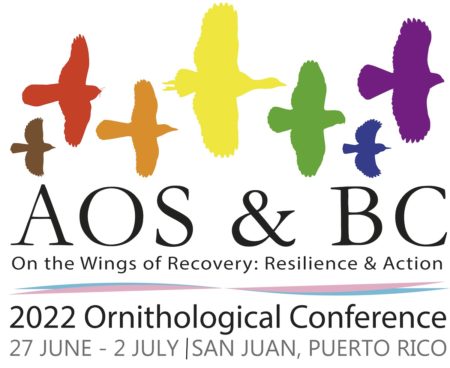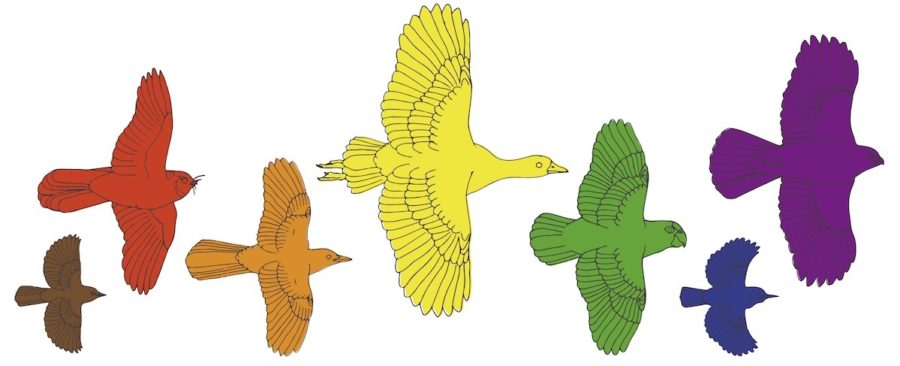
We will be flying together! For the first time, the American Ornithological Society (AOS) and BirdsCaribbean will host a joint conference in San Juan, Puerto Rico, from 27 June to 2 July, 2022, partnering with local hosts Para la Naturaleza and Sociedad Ornitológica Puertorriqueña. Held under the theme, “On the Wings of Recovery: Resilience and Action,” the conference will mark the 140th Annual Meeting of the AOS and the 23rd International Conference of BirdsCaribbean.
The conference will bring together ornithologists, wildlife professionals, educators, community leaders, students, and others to share information and learn about the latest research and innovative initiatives to conserve birds and their habitats. There will be exciting keynote and plenary speakers, symposia, workshops, roundtable discussions, contributed papers, and posters. In addition, we will have a variety of exhibitors from the commercial, non-profit, and government sectors. We will also host a series of daily, fun networking events for you to make new connections and reconnect with colleagues. Finally, numerous field trips will be offered to give you a chance to explore and bird in fabulous Puerto Rico. We are looking forward to meeting in person!*
Latest News and Updates
Conference logo celebrates theme: “On the Wings of Recovery: Resilience and Action”
Now let us take a closer look at the conference logo. Designed by the super-talented young artist and biologist Josmar Esteban Marquez, the logo reflects the theme, depicting six of Puerto Rico’s 17 endemic species or subspecies and one regional endemic. These include the Puerto Rican Parrot (Iguaca) which has made a remarkable recovery since 1975, when only a handful remained in the wild. There are now over 500, thanks to captive breeding and the release of individuals into their forest habitat, with more than half now reproducing in the wild. What an example of resiliency!
Here are the species so beautifully depicted in our logo, from left to right:
 The Elfin-woods Warbler (Setophaga angelae) is a dainty, mostly black and white warbler, endemic to a few forested areas on the island such as the El Yunque. It was first discovered by ornithologists in 1969! Its call is not as musical as you might expect, but territorial pairs do sing duets while defending territory – and they apparently mate for life.
The Elfin-woods Warbler (Setophaga angelae) is a dainty, mostly black and white warbler, endemic to a few forested areas on the island such as the El Yunque. It was first discovered by ornithologists in 1969! Its call is not as musical as you might expect, but territorial pairs do sing duets while defending territory – and they apparently mate for life.
The Puerto Rican Nightjar (Antrostomus noctitherus) is an Endangered endemic species. The males sing throughout the year and during the breeding season they incubate young on the ground in the daytime. They are more abundant in the upland forest in and around the Guánica Biosphere Reserve, where they feed on insects under the canopy during the night.
The Yellow-shouldered Blackbird, (Agelaius xanthomus), locally named “Mariquita,” is another Endangered endemic species mainly to be found in the mangrove zone of southwestern Puerto Rico and on Mona Island. It has suffered greatly from brood parasitism by the invasive Shiny Cowbird, which lays its eggs in the Blackbird’s nests. The blackbird has many displays and vocalizations and usually walks on the ground.
The elegant West Indian Whistling-Duck (Dendrocygna arborea) is endemic to the Caribbean region and one of the rarest ducks in the Americas – despite being down-listed to Vulnerable status in 2019 by BirdLife International. It can be found in freshwater and saline wetlands, including coastal mangroves, lagoons, and tidal flats, and forages for berries, seeds and grain, mostly at night.
The Critically Endangered Puerto Rican Parrot (Amazona vittata) is a beautiful endemic species threatened by predation, the caged bird trade, and natural disasters such as hurricanes; but is benefiting greatly from the ongoing recovery program. It is almost entirely green, with blue-edged wings and a bright red frontal band.
An endemic species, the Puerto Rican Tody (Todus mexicanus) is called San Pedrito, Medio peso, and Papagayo locally. This bright gem of a bird lives in wooded areas from the coast to mountainous areas and often makes itself heard. It nests in burrows in earth banks.
The Puerto Rican Sharp-shinned Hawk, (Accipiter striatus venator), an endemic subspecies, is a rare sight, best spotted in the Toro Negro and Maricao forests. A solitary, rather secretive hawk with a small head and large eyes, it usually launches surprise attacks on its prey from the air, but will also pursue prey on the ground.
As we have already noted, habitat destruction for urban developments and agriculture has been a contributing factor to the declining numbers of these species, as well as predation by invasive species. In recent years, the increased frequency and severity of tropical storms (such as Hurricanes Irma and María in 2017) and other impacts of climate change have also created problems for humans and wildlife in general. Puerto Rico’s endemics and other bird species face many challenges.
At our joint conference in San Juan, we will discuss actions to be taken to boost the resilience of these and other birds, and to give them “wings of recovery!” We look forward to having you join us, as we strategize for a better tomorrow – not only for the island’s wonderful birds, but for those across the Americas!
*NOTE: We are closely monitoring current pandemic conditions and will follow guidance and ordinances provided by local health authorities regarding travel, masking, and social-distancing requirements during the conference. All attendees of AOS & BC 2022 will be required to be fully vaccinated, as defined by U.S. Centers for Disease and Control Prevention (CDC) guidelines. Conference hashtag: #AOS_BC_22 https://youtu.be/5YsUEviRYiw
